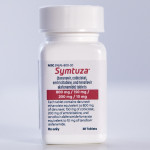Once-daily Norvir (ritonavir)-boosted Prezista (darunavir) is more likely to keep viral loads undetectable in HIV-positive people starting antiretroviral (ARV) therapy for the first time, compared with Kaletra (lopinavir plus ritonavir), according to new long-term study results. The latest data, reported October 26 at the 2008 joint meeting of the Interscience Conference on Antimicrobial Agents and Chemotherapy (ICAAC) and the Infectious Disease Society of America (IDSA) in Washington, DC, also indicate that Norvir-boosted Prezista results in smaller increases in triglyceride and total cholesterol levels and is less likely to cause diarrhea, compared with Kaletra.
The U.S. Food and Drug Adminisration (FDA) recently approved Norvir-boosted Prezista for HIV-positive people starting therapy for the first time, at a dose of two 400 mg tablets plus one 100 mg Norvir capsule once a day. The FDA’s approval was based in part on strong 48-week results from Tibotec’s ARTEMIS study, comparing this Norvir-boosted Prezista dose to Kaletra in treatment naïve patients.
ARTEMIS, scheduled to follow study volunteers for three and a half years, randomized 343 patients to receive Norvir-boosted Prezista and 346 patients to receive Kaletra. All patients in the study also took Truvada (tenofovir plus emtricitabine).
The 96-week results from the study were reported at ICAAC/IDSA by Anthony Mills, MD, a researcher and private physician based in Los Angeles.
At the start of the study, patients’ viral loads averaged 70,800 in the Prezista/Norvir group and 62,100 in the Kaletra group. CD4 counts averaged 228 and 218 cells, respectively. About 35 percent of the patients in both study groups began treatment with high viral loads—in excess of 100,000 copies.
According to Dr. Mills, 17 percent of those in the Prezista group and 23 percent of those in the Kaletra group prematurely discontinued therapy. About 4 percent taking Prezista discontinued due to side effects, compared with roughly 9 percent of those taking Kaletra.
Whereas rates of undetectable viral loads (below 50 copies) were roughly similar after 48 weeks of treatment, there was a statistically significant difference by week 96, indicating virologic superiority of Norvir-boosted Prezista over Kaletra. According to a strict intent-to-treat study analysis, 79 percent of patients receiving Norvir-boosted Prezista had viral loads below 50 copies after 96 weeks, compared with 72 percent of those in the Kaletra group.
Norvir-boosted Prezista appeared to be the more effective option for HIV-positive people entering ARTEMIS with high viral loads (above 100,000 copies) and low CD4 counts (below 200 cells). After 96 weeks, 76 percent of patients with high viral loads who took Norvir-boosted Prezista had undetectable levels, compared with 63 percent of those who took Kaletra. Similar results were seen among those who entered with CD4s below 200.
Differences between those taking Norvir-boosted Prezista or Kaletra with low viral loads (below 100,000 copies) or higher CD4 counts (above 200 cells) were not statistically significant.
Gains in CD4 counts were similar in both groups. There was a 171-cell increase in the Prezista/Norvir group compared with a 188-cell gain in the Kaletra group after 48 weeks.
As for side effects, gastrointestinal (GI) problems, including diarrhea, were more likely to occur in the Kaletra group than in the Prezista/Norvir group. GI events occurred in 15 percent of those taking Kaletra and 7 percent of those taking Prezista/Norvir. Diarrhea was documented in 11 percent of those in the Kaletra group, compared with 4 percent of those in the Prezista group. While these differences were statistically significant, it is worth noting that most patients in the Kaletra group started treatment—when the risk of diarrhea is greatest—on an older capsule formulation of the drug that is known to cause more gastrointestinal problems than the newer tablet version.
Differences in lipid changes were reported as well. After 96 weeks, triglyceride levels increased by about 50 percent in the Kaletra group, compared with a 12 percent gain the Norvir-boosted Prezista group. Total cholesterol levels also increased, by 23 percent and 15 percent respectively, as did “good” HDL cholesterol levels, by 19 and 15 percent respectively. These differences were all statistically significant.
In conclusion, Mills said that once-daily Norvir-boosted Prezista, combined with Truvada, “resulted in excellent virologic and immunologic responses,” that it was “generally well tolerated, with a favorable safety profile,” and that its “superiority was driven by better virologic response and fewer discontinuations due to [adverse events] compared with [Kaletra].”
Advertisement
Advertisement
Advertisement






Comments
Comments